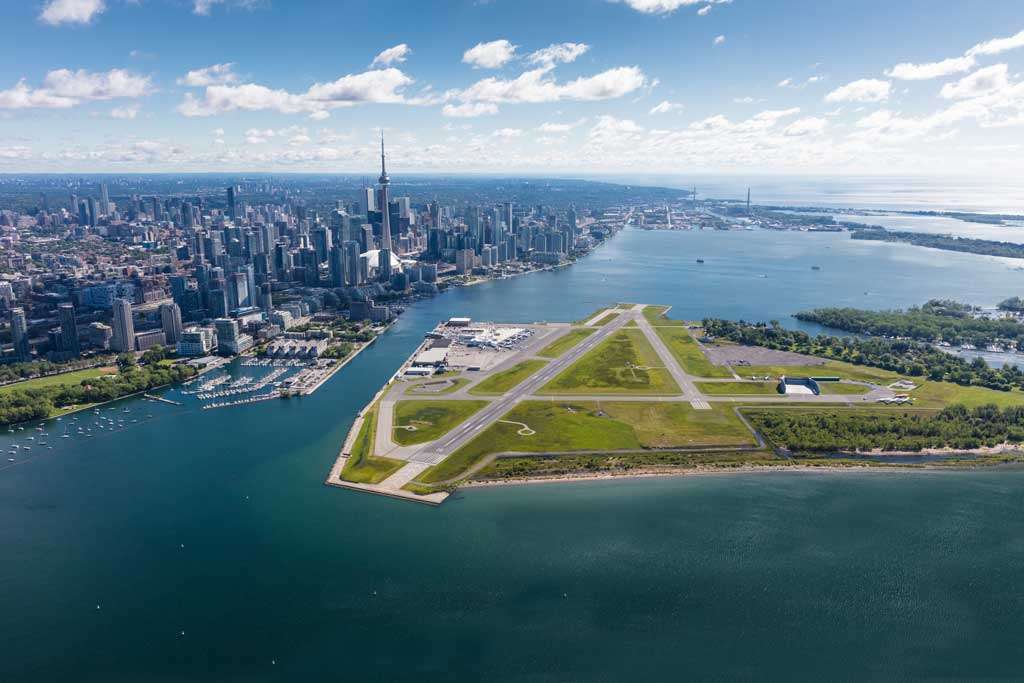PortsToronto, owner and operator of Billy Bishop Toronto City Airport, is proud to launch a celebration to mark 85 Years of Flight at Toronto’s downtown airport.
Conceived in the 1930s as the main airport for Toronto, the construction of what is now Billy Bishop Toronto City Airport was completed in 1939 by the Toronto Harbour Commission (THC), a predecessor organization of PortsToronto.
A Journey Through Time
Conception in the 1930s
Steeped in history and significance, this milestone serves as a testament to the airport’s enduring legacy and pivotal role in shaping Toronto’s aviation landscape.
In the 1930s, amidst burgeoning aviation aspirations, the Toronto Harbour Commission (THC), precursor to PortsToronto, embarked on an ambitious venture to establish Toronto’s primary airport.
This vision materialized into the construction of what is now cherished as Billy Bishop Toronto City Airport. Alongside it came the creation of Malton Airport, now known as Toronto Pearson International Airport, to serve as a contingency measure.
The Inaugural Flight
On the historic day of February 4, 1939, the inaugural flight by H.F. McLean aboard a Stinson SR-9F Reliant aircraft marked the beginning of a remarkable journey which has now spanned 85 years.
This momentous occasion laid the foundation for Billy Bishop Toronto City Airport’s illustrious trajectory in aviation history.
[monsterinsights_popular_posts_inline]

The Era of Commercial Aviation
September 8, 1939, witnessed the dawn of commercial aviation at Billy Bishop Toronto City Airport, as it welcomed its maiden passenger flight.
Notably, the arrival of famed trumpet virtuoso Tommy Dorsey and his swing-band catalyzed the airport’s emergence as a cultural and logistical hub, setting the stage for decades of growth and prosperity.

Reflecting on Milestones
World War II and Beyond
During the tumultuous years of World War II, Billy Bishop Toronto City Airport assumed a pivotal role as a base for allied pilot training, highlighting its resilience and adaptability in times of adversity.
The airport served as a training ground for both the Royal Canadian and Royal Norwegian Air Forces. As a result, the neighbouring Little Norway Park was named in honour of the Norwegian community that settled around the airport in 1940.
Post-war, the airport then transitioned into a vital conduit for trade, tourism, and connectivity, fostering socio-economic development on regional and national scales.

Connectivity and Community
Through its enduring commitment to excellence, Billy Bishop Toronto City Airport has emerged as a lifeline for Ontarians, facilitating critical medical transport services and nurturing vibrant communities such as Little Norway Park.
The airport provides a base for Ornge medevac services and medical transportation charities such as Hope Air to quickly and easily access Toronto’s hospital system.
Moreover, its status as an international gateway has catalyzed Toronto’s economic prowess, generating substantial economic output and fostering employment opportunities.
It is a key driver of Toronto’s economy, generating more than $2.1 billion in total economic output and supporting 4,450 jobs.

Embracing the Future: Vision and Aspiration
As it commemorates 85 Years of Flight, PortsToronto reaffirms its dedication to steering Billy Bishop Toronto City Airport towards a future defined by innovation, sustainability, and inclusivity.
By prioritizing award-winning service, fostering economic prosperity, and strengthening global connections, we remain steadfast in our mission to propel Toronto to new heights of aviation excellence.

Click the banner to subscribe to our weekly newsleter.
whatsapp-banner]









